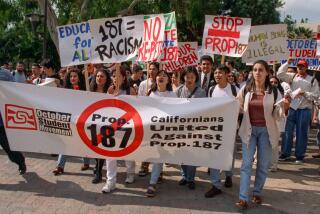Census 2000 questionnaires provided more options under...
- Share via
Census 2000 questionnaires provided more options under ethnicity than in previous years, and for the first time allowed people to identify themselves with more than one race.
People of mixed ethnic or racial identity were in the forefront in seeking those changes. The modifications also were welcomed by Latinos unhappy with previous Census options. Disagreement among Latinos over ethnic terms, however, is unlikely to end.
“No matter what term you use, you’re never going to be able to please everybody all the time,” said Harry Pachon, president of the Tomas Rivera Policy Institute, a Latino research organization in Claremont.
Disagreement stems from the wide social and political diversity among Latinos and from misunderstanding of how the terms Latino and Hispanic are used.
The differences can lead to emotional discussions--and more.
“At academic conferences, we’ve seen people literally come to blows over the terms Hispanic and Latino,” Pachon said.
Ethnic terms changed throughout the last century, a reflection not only of language but also of sociopolitical conditions in different eras.
Today, ‘Latino” and “Hispanic” are the two umbrella ethnic terms most commonly used to refer in the aggregate to two or more subgroups in this population--for example, Mexican Americans and Cuban Americans together.
“Latino” was adopted by The Times in the late 1970s as the preferred umbrella term. At that time, it was used primarily in Southern California but since has won wider acceptance nationwide.
“Hispanic” was adopted by the federal government for the Census beginning in 1980. Its use is more common on the East Coast, in government publications and in marketing.
Most individuals in the United States with Latin American roots refer to themselves by a designation of their country of origin, such as Mexican American, or Puerto Rican, or Salvadoran--terms that refer to ethnicity.
Race is a different matter and, again, confusion often develops because Latinos can be of any race.
The Census questions rely on self-identification. Some Latinos consider themselves white, or Caucasian. Others say they are mestizo, or mixed race (of Spanish and Indian descent). Still others are black or Asian racially. Members of the Mexica movement in Los Angeles and others with strong indigenous roots prefer to use Indian or Native American as their race.
In addition, there are individuals who are Latino and another race or ethnic group. Under the new wording in the 2000 Census they--and others in similar situations--were able to indicate that they are of more than one group.
Then there are Latinos who, like others around the country, hate all of the ethnic modifiers and want to be known solely as “Americans.”
One question on the 2000 Census form asked if the respondent was of Hispanic/Latino origin. Those who answered yes were then asked to indicate what country they or their ancestors were from.
The next question asked about race and allowed respondents to choose one or more races. An expanded list of Asian/Pacific Islander categories and blank spaces that could be filled in were also provided in that section.
The Census’ long form--sent to one in every six households--included an item on ancestry and gave such examples as Italian, Cambodian, African American, Polish and Mexican.
Data from those questions, along with other detailed Census findings, are scheduled to be reported beginning in March.
More to Read
Sign up for Essential California
The most important California stories and recommendations in your inbox every morning.
You may occasionally receive promotional content from the Los Angeles Times.













